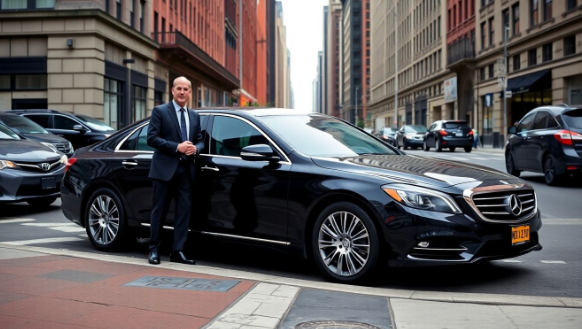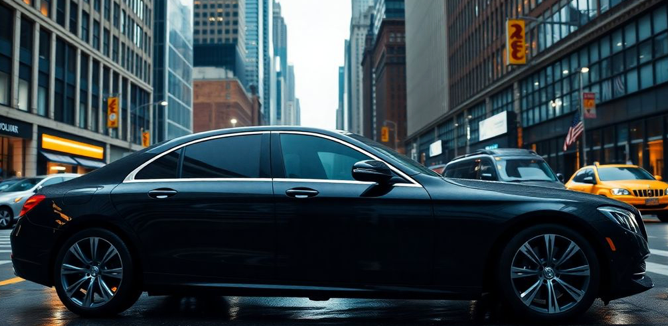How Much Is a Full-Time Driver in New York? A 2025 Cost Guide
How Much Is a Full-Time Driver in New York? Let's break down how much

This post breaks down how much is a full-time driver in New York in 2025. I ran into a heap of numbers while looking for a steady driver—base pay, regional tweaks, benefits, even parking fees. So I pulled it all together in one place. You’ll get a quick look at yearly pay ranges, hidden costs, and some smart tips to keep your spending low. And why hiring a driver from a local limousine or car service company might be the better option.
Key Takeaways
- Full-time drivers in NYC usually earn between $40,000 and $70,000 per year, with pay shifting by borough and experience level.
- Total cost goes beyond salary—think health benefits, insurance, fuel, upkeep, tolls, parking and possible overtime fees.
- Hourly rates suit short gigs, but if you need a driver every day, an annual salary often saves money and adds perks.
- Main cost drivers include the driver’s credentials, vehicle type and age, local licensing rules, and work schedule demands.
- You can cut costs by negotiating all-in-one service deals, booking off-peak hours, picking fuel-efficient cars, and writing clear contracts.
How Much Is A Full-Time Driver In New York: Annual Overview
Standard Annual Salary Benchmarks
Okay, so you're thinking about hiring a full-time driver in New York. Let's talk money. The salary range can be pretty wide, but generally, you're looking at somewhere between $40,000 and $75,000 a year. This is just a starting point, though. Several things can push that number up or down. Think about it: a driver with years of experience and a spotless record is going to command a higher salary than someone just starting out. Also, the type of driving you need matters. Are they just doing basic errands, or are they chauffeuring executives around town?
Regional Variations In Compensation
New York City isn't exactly known for being cheap, and that goes for driver salaries too. You'll probably pay more in Manhattan than you would in, say, upstate New York. Location, location, location, right? The cost of living is higher in the city, so salaries need to reflect that. Plus, demand plays a role. If there's a lot of competition for drivers in a certain area, prices will naturally go up. Here's a quick look at how things might vary:
- Manhattan: $75,000 - $120,000+
- Brooklyn/Queens: $65,000 - $75,000
- Upstate NY: $45,000 - $60,000
Included Benefits And Perks
Don't forget about benefits! When you hire someone full-time, you're usually on the hook for more than just their salary. Health insurance is a big one, and that can add a significant chunk to your overall costs. Paid time off (vacation, sick days) is another common benefit. Some employers also offer retirement plans, like a 401(k), or other perks like bonuses or company cars. All these things add up, so make sure you factor them into your budget. Here's a list of common benefits to consider:
- Health Insurance
- Paid Time Off
- Retirement Plan
- Bonuses
"It's easy to focus solely on the base salary, but overlooking benefits and perks can lead to serious budget miscalculations. Always get a clear picture of the total compensation package before making a hiring decision."
Key Factors Affecting Full-Time Driver Costs
Driver Experience And Qualifications
The more experience a driver has, the more you'll likely pay. It's pretty simple. A driver fresh out of training is going to cost less than someone with years of experience navigating New York traffic and handling demanding clients. Qualifications also matter. Does the driver have special certifications, like defensive driving or executive protection training? These will increase their value and, therefore, their price. It's a balance between what you need and what you're willing to spend.
Type And Condition Of Vehicle
The vehicle itself plays a big role in the overall cost. Are you providing the car, or is the driver? If you're providing it, you're responsible for all the associated expenses: insurance, maintenance, and fuel. A luxury vehicle will obviously cost more to maintain and insure than a standard sedan. The condition of the vehicle also matters. Older cars might have lower upfront costs, but they can quickly become money pits with frequent repairs. Consider the long-term costs when choosing a vehicle. If you need to find affordable driver services, consider a less expensive vehicle.
Local Insurance And Licensure Requirements
New York has specific insurance and licensure requirements for drivers, especially those operating commercially. These requirements can add a significant layer of cost. Commercial insurance, for example, is typically much more expensive than personal insurance. Make sure your driver has all the necessary licenses and that your insurance coverage is adequate. Failing to do so can result in hefty fines and legal trouble. It's worth doing your homework to understand the full scope of these regulations.
Duration And Schedule Commitments
How long do you need a driver each day, and what's the overall duration of the employment? A full-time driver working a standard 40-hour week will have a different cost structure than someone working irregular hours or on a short-term contract. Overtime, weekend work, and holiday pay can all add to the expense.
"Consider whether you need a driver available at all hours or if you can schedule driving services during specific times. Flexibility on your end can potentially lead to cost savings."
Here's a quick breakdown:
- Standard Hours: Predictable schedule, potentially lower costs.
- Irregular Hours: Higher costs due to overtime and scheduling challenges.
- Long-Term Commitment: May allow for negotiation of a lower rate.
Comparing Full-Time Hire Against Hourly And Contract Options
Evaluating Hourly Rate Implications
Okay, so let's break down the hourly thing. At first glance, paying a driver by the hour seems like a great way to save money, especially if you only need someone occasionally. But think about it – those hourly rates can really add up. You're not just paying for the time they're driving; you're also potentially paying for their travel time to you, minimum hour requirements, and surge pricing during peak times. Plus, you might be stuck coordinating schedules and hoping they're available when you need them. It's like, convenient in theory, but the costs can sneak up on you. For example, you might end up paying $90-$150 per hour.
Contractual Versus In-House Arrangements
Now, let's talk contracts versus having a driver on staff. A contract driver gives you flexibility. You agree on a set price for specific services, and that's that. No benefits to worry about, no payroll taxes, none of that HR headache. However, you also have less control. They might not be as invested in your needs as someone who's part of your team. An in-house driver, on the other hand, is dedicated to you. They're part of your company culture, and you can train them to meet your exact requirements. But, you're also responsible for their salary, benefits, and all the legal stuff that comes with being an employer. It's a bigger commitment, but it can pay off in terms of loyalty and reliability.
Long-Term Financial Benefits
So, what's the best financial move in the long run? It really depends on your needs. If you only need a driver a few times a month, sticking with hourly or contract options might be the way to go. But if you need someone regularly, crunch the numbers on a full-time hire. Consider the cost of benefits, insurance, and potential overtime. Then, compare that to the projected costs of hourly or contract drivers over a year. You might be surprised to find that a full-time driver, while seemingly more expensive upfront, actually offers better freelance payment model in the long haul, especially when you factor in the value of their dedication and availability.
"It's important to consider the hidden costs. With hourly or contract drivers, you might face surge pricing, cancellation fees, or unexpected charges. A full-time driver provides more predictable expenses, making budgeting easier. Plus, the peace of mind knowing you have a reliable driver whenever you need them is priceless."
Here's a quick comparison:
- Hourly: Best for occasional use, but costs can fluctuate.
- Contract: Offers flexibility, but less control.
- Full-Time: Most reliable, but requires a larger investment.
Uncovering Hidden Expenses In Driver Employment
It's easy to focus on the base salary when hiring a full-time driver, but there are other costs that can really add up. Careful planning can help you avoid surprises and keep your budget on track. Let's break down some of these often-overlooked expenses.
Overtime And Holiday Surcharges
Overtime is a big one. If your driver works beyond their regular hours, you'll likely need to pay a higher hourly rate. This is especially true for evenings, weekends, and holidays. Make sure your contract clearly defines overtime policies to avoid disputes. Also, remember that holiday work often comes with premium pay, so factor that into your budget if you anticipate needing driving services on those days.
Fuel And Maintenance Responsibilities
Who pays for gas? What about oil changes, tire rotations, and other routine maintenance? These costs can be significant, especially if the driver is using their own vehicle. Even if you provide the vehicle, you're still responsible for keeping it in good working order. Consider setting up a maintenance schedule and budget to handle these expenses proactively. You might want to look into employee cost breakdown to get a better idea of the overall financial impact.
Parking And Toll Fee Coverage
Parking in New York City is notoriously expensive, and tolls can also add up quickly. Will you reimburse your driver for these expenses? If so, you'll need a system for tracking and processing these payments. Consider providing a company credit card or setting up an expense reimbursement process. It's also worth exploring options like monthly parking passes or E-ZPass to potentially save money on toll fee coverage.
"Don't forget about potential gratuity. While not always mandatory, tipping is customary for good service, and your driver may expect it, especially during the holiday season. Factoring in a reasonable amount for tips can help keep your driver happy and motivated."
Strategies To Lower Costs For Dedicated Driving Services
It's no secret that having a full-time driver in New York can be a significant expense. But don't worry, there are ways to make it more affordable. Let's explore some strategies to keep those costs down.
Negotiating All-Inclusive Service Packages
Instead of paying separately for every little thing, try to bundle services. Many companies offer all-inclusive packages that cover things like maintenance, insurance, and even fuel. This can give you a more predictable monthly cost and potentially save you money compared to piecemeal charges. Think of it like buying in bulk – often cheaper in the long run. You might find that some providers are willing to work with you to create a custom package that fits your specific needs and budget. Don't be afraid to ask for a discount; it never hurts to try!
Scheduling During Off-Peak Hours
Peak hours mean higher demand, which translates to higher prices. If your schedule allows, try to arrange your trips during off-peak times. This could mean avoiding rush hour or scheduling appointments for mid-day instead of early morning or late afternoon. You might be surprised at how much you can save simply by being flexible with your timing. Plus, you'll likely encounter less traffic, making your journey more pleasant overall.
Choosing Cost-Effective Vehicle Models
The type of vehicle your driver uses can have a big impact on your overall costs. A gas-guzzling SUV will obviously be more expensive to operate than a fuel-efficient sedan. Consider opting for a more economical vehicle model to reduce fuel costs and potentially lower insurance premiums. Also, think about whether you really need a luxury vehicle or if a more practical option would suffice. Remember, the goal is to get from point A to point B safely and comfortably, without breaking the bank. Consider alternatives to car ownership to reduce costs.
"One often overlooked aspect is the maintenance cost associated with different vehicle models. Some cars are simply more expensive to repair than others. Research the long-term maintenance costs of different vehicles before making a decision. A little bit of research upfront can save you a lot of money down the road."
Expected Salary Tiers For Full-Time Drivers In New York
It's important to understand the different salary expectations for full-time drivers in New York, as they vary greatly depending on experience and the type of driving required. Let's break down the salary tiers you can expect to see in 2025.
Entry Level And Training Roles
Entry-level positions, such as trainee drivers or those with limited experience, will naturally command lower salaries. These roles often involve more training and supervision, which is reflected in the compensation. You might find these positions advertised with salaries ranging from $30,000 to $45,000 annually. These roles are a good starting point to gain experience and move up the salary ladder. It's worth noting that even at this level, benefits can significantly impact the overall compensation package.
Experienced Professional Salaries
Experienced drivers, with a proven track record and clean driving history, can expect a much higher salary. These professionals often possess specialized skills, such as defensive driving or knowledge of specific routes and traffic patterns. Salaries in this tier typically range from $75,000 to $95,000 per year. The demand for experienced drivers in New York is high, especially those who can demonstrate reliability and professionalism. For example, truck drivers in New York earn a good salary.
Executive And Luxury Chauffeur Rates
For executive and luxury chauffeur positions, the salary expectations are even higher. These roles require a high degree of professionalism, discretion, and often specialized training in security and customer service. Chauffeurs driving for executives or high-profile individuals can command salaries ranging from $90,000 to $120,000+ annually. The higher end of this range often includes significant benefits, bonuses, and perks. The salary depends on:
- The level of experience.
- The type of vehicle driven.
- The specific requirements of the client.
"It's important to remember that these are just estimates, and the actual salary may vary depending on the specific employer, the location within New York, and the current market conditions. Always research and negotiate to ensure you're receiving fair compensation for your skills and experience."
Drafting Contracts For Clear Driver Pricing

Defining Scope And Services
When you're hiring a full-time driver in New York, the contract is everything. It's not just a formality; it's the foundation of a good working relationship and clear expectations. The first thing to nail down is the scope of services. What exactly will the driver be doing? Is it just driving, or are there other responsibilities like running errands, vehicle maintenance, or managing schedules? Be specific. A vague contract leads to misunderstandings and potential disputes down the line. For example, clearly state the expected work hours, geographical limitations (if any), and the types of vehicles the driver will be operating.
Setting Payment And Bonus Structures
Next up: money. The contract needs to clearly outline the payment structure. Will the driver be paid a fixed salary, hourly, or a combination of both? What about overtime? How is that calculated and compensated? Are there any bonuses involved, and if so, what are the criteria for earning them? For example, a bonus could be tied to performance, such as maintaining a clean driving record or consistently receiving positive feedback. It's also a good idea to include a payment schedule, specifying when and how the driver will be paid (e.g., bi-weekly via direct deposit).
Establishing Cancellation And Overtime Policies
Finally, let's talk about the what-ifs. What happens if you need to cancel the driver's services? What's the notice period required? Are there any penalties for early termination? Similarly, what's the policy on overtime? How much notice does the driver need to be given for overtime work, and how is it compensated? Having clear cancellation and overtime policies in the contract can prevent a lot of headaches down the road. It's also worth including a clause about dispute resolution, outlining the steps to be taken if any disagreements arise.
"A well-drafted contract protects both you and the driver. It sets clear expectations, minimizes the risk of misunderstandings, and provides a framework for a smooth and productive working relationship. Don't skimp on this step – it's an investment that can save you time, money, and stress in the long run."
Here's a quick checklist for your driver contract:
- Detailed job description
- Payment terms (salary, hourly rate, overtime)
- Bonus structure (if applicable)
- Cancellation policy
- Overtime policy
Conclusion
Well, that wraps up our look at how much is a full-time driver in New York can cost. It’s not exactly cheap. Between salary, benefits, fuel, tolls, and parking, you could end up spending $40K to $70K a year—or more if you need extra hours or a posh ride. If you just need someone now and then, hourly pay might make more sense. But if you use a driver every day, an annual salary could save you money in the long run. Make sure you cover all the bases. Contact local limousine or car service companies in the area and inquire about hiring a full-time driver. Get a few quotes and ask about any extra fees before you sign on the dotted line.
Frequently Asked Questions
How much does a full-time driver in New York make each year?
On average, a full-time driver in New York earns between $50,000 and $120,000 per year. The exact pay depends on experience, the type of vehicle, and the part of the city they work in.
Do full-time drivers get extra benefits?
Yes. Many full-time drivers receive health insurance, paid time off, and retirement savings plans. These benefits can add thousands of dollars to the total cost.
Are there extra costs beyond salary?
Absolutely. You may need to cover overtime pay, fuel, regular vehicle upkeep, tolls, and parking fees. These hidden expenses can raise the overall cost by 15%–20%.
Is it cheaper to hire hourly drivers instead?
For short or occasional trips, hourly drivers might cost less. But if you need a driver every day, a full-time salary usually gives you more predictable costs and extra perks.
Can I negotiate a lower rate or package deal?
Yes. You can ask for bundled services—like fuel and maintenance included—to lock in a flat monthly fee. You can also shop around and compare offers from different agencies.
What should be in the driver contract to avoid surprises?
Your contract should spell out work hours, overtime rates, covered expenses (fuel, tolls, parking), cancellation fees, and any extra charges. Clear rules help prevent confusion later.










